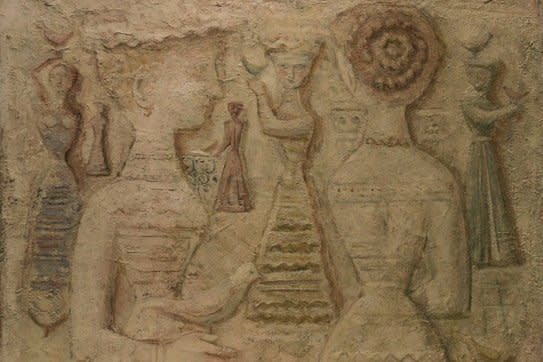35 paintings dialogue with ancient finds at Palazzo Franchetti

Massimo Campigli, Donne e uccelli, 1944, olio su tela, cm. 72 x 92
Campigli and the Etruscans face to face on the Grand Canal, in one of the most famous Gothic architecture of the lagoon city, Palazzo Franchetti. The exhibition conceived by Franco Calarota, scheduled from 23 May to 30 September, is an ambitious and far-reaching project that involves experts of the twentieth century, Superintendencies and Museums, mirroring an era in which the cultural offer in general needs to be reformulated: "Times have changed and will change again, it is no longer possible to hold exhibitions without content and without a project that makes the general public reflect", explains Calarota, president of Acp (Art Capital Partner) - Palazzo Franchetti, the company that manages the events cultural heritage in the building owned by the Veneto Institute of Sciences, Letters and Arts. On display about fifty Etruscan finds identified with the collaboration of the Superintendence of Archeology, Fine Arts and Landscape for the Metropolitan Area of Rome, the Province of Viterbo and the Southern Etruria, among these two rare terracotta sarcophagi of the Civic Museum of Viterbo. Many of the exhibits, amphorae, vases, figurines, jewels and much more come from recovery operations from important international museums and are now owned by the museums of Vulci, Tarquinia, Cerveteri and Viterbo. Next to them 35 paintings by Massimo Campigli dated from 1928 to 1966. The stylized and oriental figures, the geometric volumes and the pastel colors similar to those of the frescoes faded by time characterize the entire production of the artist after 1928, the year in which he visited the Etruscan Museum of Villa Giulia in Rome, being struck by this ancient civilization that many Italian artists of the twentieth century intrigued, from Arturo Martini to Marino Marini, Fausto Melotti and Leoncillo, just to name a few.
The exhibition path is divided into three sections and underlines the references and similarities with Etruscan shapes: human figures (men and women), animals (birds, horses and wild species) and geometric profiles of amphorae and vases. A suspended atmosphere, which highlights the universality of art beyond any era and origin. In conjunction with the opening of the exhibition, another inauguration will enliven the splendid Palazzo, the opening of a restaurant by Arrigo Cipriani (see p. 6). On the first floor it is also possible to visit the permanent collection which exhibits in rotation works by important international artists of the twentieth century, from Magritte to Morandi, to Klee. Among the future programs, however, an exhibition on the command sticks of Oceanic art in October, which will later stop at the Musée du quai Branly in Paris (organized in collaboration with the Ligabue Foundation of Venice). And for the 2022 Biennale Arte a major exhibition on Morandi and Rothko.
